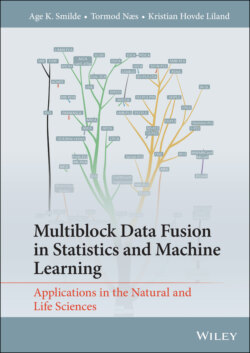Читать книгу Multiblock Data Fusion in Statistics and Machine Learning - Tormod Næs - Страница 18
1.3.2 High-, Mid- and Low-level Fusion
ОглавлениеThe data fusion literature (see, e.g., Mitchell (2012); Kedem et al. (2017); van Loon et al. (2020)) distinguishes between different ways of putting data blocks together. Here we will focus on one of these distinctions, namely between measurement level fusion, feature level fusion, and decision level fusion. Other names used for this are low-level, medium/intermediate/mid-level, and high-level fusion, respectively. For the case of supervised analyses, the three are illustrated in Figure 1.1. Low-level fusion means that the data blocks are simply concatenated and then analysed together as one single block. Mid-level fusion refers to first extracting features from each block before putting them together in a regression or classification model. High-level fusion means that predictions based on single input blocks are established before combining the results, see Elaboration 1.2. For unsupervised analyses, we can also distinguish between these different levels of fusion. In low-level fusion, the data blocks are used as such in an unsupervised multiblock data analysis method without any pre-selection of variables. In mid-level fusion, first the most important variables are selected per block and then an unsupervised fusion method is used. Such an approach is often taken in genomics where several thousands of variables are measured and filtered before entering any kind of modelling (see Section 1.4.2 for examples). High-level fusion would entail an unsupervised analysis per data block and then combining the results with visualisation tools. This approach is not taken very much. In this book we will focus on low-level and mid-level fusion.
Figure 1.1 High-level, mid-level, and low-level fusion for two input blocks. The Z’s represent the combined information from the two blocks which is used for making the predictions. The upper figure represents high-level fusion, where the results from two separate analyses are combined. The figure in the middle is an illustration of mid-level fusion, where components from the two data blocks are combined before further analysis. The lower figure illustrates low-level fusion where the data blocks are simply combined into one data block before further analysis takes place.
